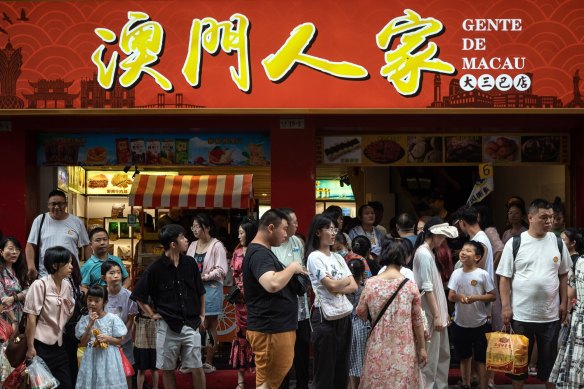
China was originally in column two but between 1980 and 2001, when it joined the WTO, the more punitive tariffs were waived, annually. As a member of the WTO, it received the most favoured nation status and its exports exploded. Its exports to the US have increased more than 300 per cent since then, despite Trump’s trade war.
Revocation of its PNTR status would be mutually destructive and even more so if China were to retaliate with more tariff increases of its own.

China’s battered economy would suffer greatly if Trump wins in November.Credit: Bloomberg
Last year, a study by Oxford Economics concluded that if Trump were to increase the tariff on all China’s exports to the US from their current average of about 19 per cent to 61 per cent, it would shrink US GDP by $US1.6 trillion ($2.3 trillion) over five years and cost 744,000 jobs over the same period.
If China retaliated, the net negative impact on GDP would be $US1.9 trillion and there would be 801,000 fewer jobs.
Another study by the Peterson Institute for International Economics last month (co-authored by Australian economist Warwick McKibbin) concluded that revocation of China’s PNTR status would cause a short-term decline in America’s GDP that would never be fully recovered.
Loading
Inflation would rise by 20 to 40 basis points relative to the status quo (depending on how China responded), stock prices would fall and the US trade deficit would rise.
The hardest-hit US sectors would be agriculture, mining and the manufacturing of durable goods.
China, with an economy increasingly reliant on exports, would obviously suffer greater damage in the short term – the institute says it would have a 60-basis point decline in real GDP in 2026 – and production would inevitably shift out of China to lower-tariff countries in the longer term.
China would presumably reorient its trade away from the US to other economies (all of whom would be embroiled in their own trade disputes with the US because of the baseline tariffs), with a particular focus on its own region, Russia and South America, where it has been building its trade and diplomatic relationships.
With even Europe already planning how it might respond to the baseline tariffs, the US could become what Trump envisages – an isolated, largely self-contained economy.
Where his last trade war with China, and to a lesser extent some of America’s traditional allies, had modestly negative impacts on the US and Chinese economies, the new trade strategy he has promised to introduce would do far more damage to the United States and its trade partners.
It’d be far poorer for the shift, but that doesn’t appear to concern the protectionists and China hawks advising Trump on trade who, like the former president, have this bizarre conviction that Chinese exporters pay the US tariffs rather than, as everyone else understands, US companies and consumers.
There would be no winners from a new Trump trade war, although Canada and Mexico might hope to gain due to their free-trade agreement with the US and their potential as a duty-free backdoor entry to the US market.
Loading
Their status would, however, be unlikely to survive Trump’s proposed new trade regime – he’s threatened the iconic John Deere agricultural equipment manufacturer with 200 per cent tariffs if it proceeds with plans to shift some manufacturing to Mexico.
The General Agreement on Tariffs and Trade, signed by 23 countries in 1947, was in part a response to the perceived role that protectionism and the poisoning of international relations in the 1930s had played in the Great Depression and the lead-up to World War II. It was the predecessor to the WTO, created in 1995, which added services and intellectual property to the GATT’s coverage of goods.
The rules-based trade system, which hinges on PNTR status, would be torn up if Trump returns as president and implements his tariffs.
Instead, there’d be directly negotiated deals between individual countries, with the bigger and stronger economies holding the upper hand in the negotiations, and the smallest and least powerful economies left staring at steep tariff walls – an outcome that the GATT and WTO regimes were designed to prevent, for fear of the consequences of a free-for-all in global trade.









 Add Category
Add Category